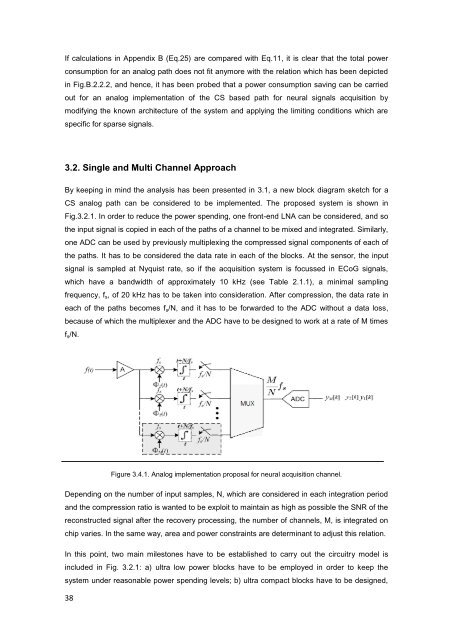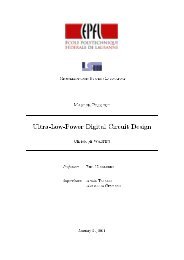Compressive Sensing system for recording of ECoG signals in-vivo
Compressive Sensing system for recording of ECoG signals in-vivo
Compressive Sensing system for recording of ECoG signals in-vivo
You also want an ePaper? Increase the reach of your titles
YUMPU automatically turns print PDFs into web optimized ePapers that Google loves.
If calculations <strong>in</strong> Appendix B (Eq.25) are compared with Eq.11, it is clear that the total powerconsumption <strong>for</strong> an analog path does not fit anymore with the relation which has been depicted<strong>in</strong> Fig.B.2.2.2, and hence, it has been probed that a power consumption sav<strong>in</strong>g can be carriedout <strong>for</strong> an analog implementation <strong>of</strong> the CS based path <strong>for</strong> neural <strong>signals</strong> acquisition bymodify<strong>in</strong>g the known architecture <strong>of</strong> the <strong>system</strong> and apply<strong>in</strong>g the limit<strong>in</strong>g conditions which arespecific <strong>for</strong> sparse <strong>signals</strong>.3.2. S<strong>in</strong>gle and Multi Channel ApproachBy keep<strong>in</strong>g <strong>in</strong> m<strong>in</strong>d the analysis has been presented <strong>in</strong> 3.1, a new block diagram sketch <strong>for</strong> aCS analog path can be considered to be implemented. The proposed <strong>system</strong> is shown <strong>in</strong>Fig.3.2.1. In order to reduce the power spend<strong>in</strong>g, one front-end LNA can be considered, and sothe <strong>in</strong>put signal is copied <strong>in</strong> each <strong>of</strong> the paths <strong>of</strong> a channel to be mixed and <strong>in</strong>tegrated. Similarly,one ADC can be used by previously multiplex<strong>in</strong>g the compressed signal components <strong>of</strong> each <strong>of</strong>the paths. It has to be considered the data rate <strong>in</strong> each <strong>of</strong> the blocks. At the sensor, the <strong>in</strong>putsignal is sampled at Nyquist rate, so if the acquisition <strong>system</strong> is focussed <strong>in</strong> <strong>ECoG</strong> <strong>signals</strong>,which have a bandwidth <strong>of</strong> approximately 10 kHz (see Table 2.1.1), a m<strong>in</strong>imal sampl<strong>in</strong>gfrequency, f s , <strong>of</strong> 20 kHz has to be taken <strong>in</strong>to consideration. After compression, the data rate <strong>in</strong>each <strong>of</strong> the paths becomes f s /N, and it has to be <strong>for</strong>warded to the ADC without a data loss,because <strong>of</strong> which the multiplexer and the ADC have to be designed to work at a rate <strong>of</strong> M timesf s /N.Figure 3.4.1. Analog implementation proposal <strong>for</strong> neural acquisition channel.Depend<strong>in</strong>g on the number <strong>of</strong> <strong>in</strong>put samples, N, which are considered <strong>in</strong> each <strong>in</strong>tegration periodand the compression ratio is wanted to be exploit to ma<strong>in</strong>ta<strong>in</strong> as high as possible the SNR <strong>of</strong> thereconstructed signal after the recovery process<strong>in</strong>g, the number <strong>of</strong> channels, M, is <strong>in</strong>tegrated onchip varies. In the same way, area and power constra<strong>in</strong>ts are determ<strong>in</strong>ant to adjust this relation.In this po<strong>in</strong>t, two ma<strong>in</strong> milestones have to be established to carry out the circuitry model is<strong>in</strong>cluded <strong>in</strong> Fig. 3.2.1: a) ultra low power blocks have to be employed <strong>in</strong> order to keep the<strong>system</strong> under reasonable power spend<strong>in</strong>g levels; b) ultra compact blocks have to be designed,38















